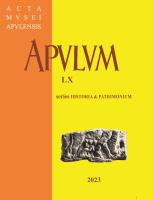MARGINALII LA UN INCUNABUL GUTENBERG: TÜRKENKALENDER (1454)
Marginal Notes to a Gutenberg´s Incunabulum: The Türkenkalender (1454)
Author(s): Constantin IttuSubject(s): History, Cultural history, Library and Information Science, Other, Middle Ages, 15th Century
Published by: Muzeul National al Unirii Alba Iulia
Keywords: Gutenberg; incunabulum; Türkenkalender; Constantinople; Leonard Archbishop of Mytilene in Chios; Isidore Metropolitan of Kiev;
Summary/Abstract: The current paper aims to introduce one of the first incunabula printed by Johannes Gutenberg, namely, the Türkenkalender. The six folio calendar was printed in December 1454, in order to be in use during the following year, 1455. According to Gutenberg´s intention, the Türkenkalender was intended to be a warning against the Ottoman danger shortly after the fall of Constantinople on May 29th 1453. The paper also includes contemporary testimonies about the last days of the Byzantine Imperial capital from two different witnesses, both members of the high clergy, one of them being Leonard Archbishop of Mytilene in Chios, and the other one being Isidore Metropolitan of Kiev. They belonged to those European writers who called the sovereigns as well as the nobility of Europe to defend Christianity. Following the same path and the same message, the inner structure of the Türkenkalender (or Calendar turcesc as it is also known in Romanian) includes twelve separate poems arranged at the beginning of each of the twelve months of the year, poems aimed to persuade the European rulers to take actions against the Turks. At the end of the calendar, Gutenberg included the oldest formula ever printed of the New Year greetings – Eyn gut selig nuwe Jar.
Journal: Apulum
- Issue Year: 60/2023
- Issue No: 1
- Page Range: 141-152
- Page Count: 12
- Language: Romanian
- Content File-PDF

